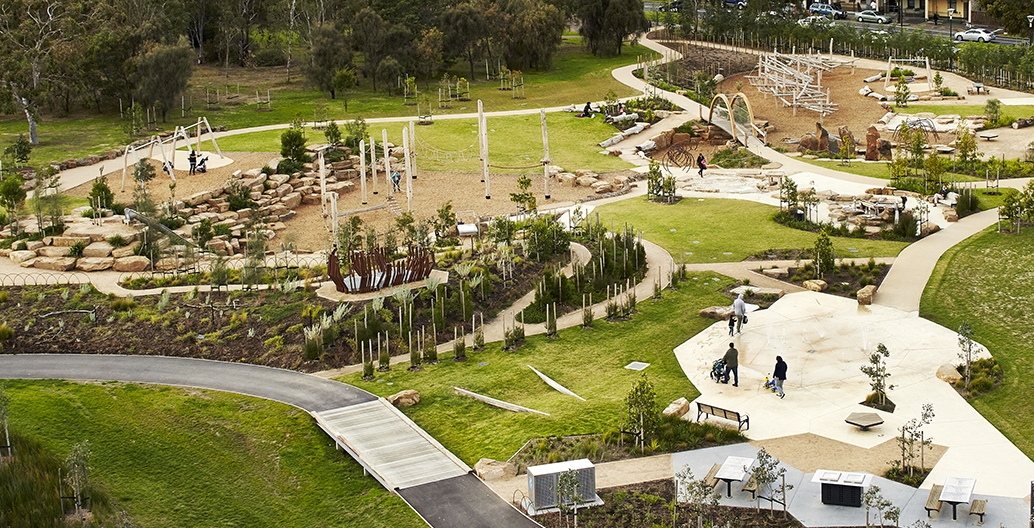
Back to nature: Playgrounds in Canberra to take play out of the box and into the world
The renewal of three parks in Australia’s capital will emphasise nature play and co-design to help change how we shape and use our public playgrounds.
A pilot program by the Australian Institute of Landscape Architects (AILA) hopes to kick-off a national conversation about the importance of play in the design and planning of our cities and urban spaces.
Craft Your Park was a partnership between AILA and the ACT Government Transport Canberra and City Services Directorate (TCCS) to design and implement natural play spaces in three existing Canberra parks with the involvement of local communities.
Nature play emphasises giving children a built environment that encourages creativity and imagination. Natural materials range from climbing frames and log steppers to fallen tree branches.
AILA named Royal Park’s ‘Nature Play’ playground in Melbourne as the best in the country earlier this year and also awarded it a Design Award in its 2015 Victorian awards ceremony.
The effects of incorporating nature play into parks have been well-documented and include such benefits as improved cognitive and psychological functioning in children. But evidence also suggests that children today are spending less time outdoors than their parents did due to a variety of factors, including the fear of kidnappings if children are left to play unsupervised.
Amanda Evans, the director of landscape architecture practice Area Design Consultants, said the national shift from a highly protective environment to one of unstructured outdoor play has been fairly recent, whereas Canberrans have always spent their time outdoors. Her team worked with landscape architecture practices Harris Hobbs Landscapes (HHL) and Nicholas Bray Landscapes, along with Brindabella Contractors on the winning proposal to redevelop the Tuggeranong Town Park.
“We consulted with a bush playgroup made up of mainly five year olds for the redevelopment of the park. The head teacher said they don’t take the children to a manmade park but always to the bush,” Evans told Foreground.
“The teacher said that if the park became rough and tumble enough then she would bring her children there. The idea of nature play was appealing enough for her to say that she may change her behaviour in where to take the children.”
But GroupGSA Associate Anika Hoffman says that while getting communities on-board may not be a challenge, convincing councils and local governments to incorporate these changes can be a slow process. Her design firm was a joint winner with Cia Landscapes + Colour in the competition to remodel Telopea Park, one of Canberra’s oldest parks.
“We are finding that often councils and those sort of authorities are still unsure about utilising nature play,” Hoffman told Foreground.
“We are incorporating little bits and pieces but it’s been a slow process to try and get it up and running properly. It’s just about changing people’s perceptions from a playground being just soft playground equipment to actually something that is a lot more interactive and creative and relies on children coming up with games.”
Shahana McKenzie, the CEO of AILA, echoed Hoffman’s comments and said that she hopes governments at all levels develop a strategy with the help of their communities to identify how play experiences can be improved upon and developed.
“I’m really hoping these three fantastic pilot nature play spaces in the ACT will be used as case studies for other projects in the ACT and nationally, whether it be councils, local governments or state governments,” she said in an interview with Foreground.
The winning teams were selected for their understanding of nature play principles, their approach in developing the space and the design of their community consultation and engagement program.
Co-design, also known as participatory design, is an approach that involves key stakeholders in every step of the design process to ensure that the completed product meets their needs and is usable. Chilean architect Alejandro Aravena became the poster boy for this approach when he was awarded the prestigious Pritzker Architecture Prize this year for his work in addressing social challenges through a participatory design process.
Spacelab’s Associate Director Geoff Bunnett, who will handle the redevelopment of Finn Street’s local park, told Foreground that the collaboration and consultations with the O’Connor cooperative school and residential community involved a lot of listening and keeping communication channels open.
“For the past three to four weeks we have been taking on-board what people want to see in the space. We are going through an iterative process to understand how we can realise those ideas and then keep going back until we get to that final design approval phase with the government,” he said.
“The biggest challenge is having the opportunity to capture all of the communities’ ideas.”
GroupGSA has sent out information packs, including colouring sheets for children, to local community groups, pre-schools and childcare centres in Barton for feedback on its ideas about the park. It has also set-up an online survey and Facebook page.
Area Design Consultants and HHL have held a number of consultations with the Greenway community and are in the process of drawing up their findings before presenting it to them next week.
All three teams aim to finish construction of the parks by July 2017. A public voting campaign will be held to decide the best built outcome.


